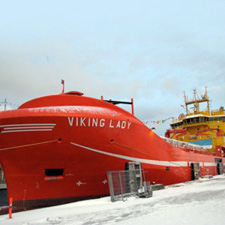 World's First Fuel Cell Ship Docks in CopenhagenCan fuel cells and natural gas help reduce emissions from shipping?Dec 21, 2009 - David Biello - Scientificamerican.comCOPENHAGEN—Pleasure yachts and tall ships line the wharves and quays of Nyhavn here in the Danish capital. Shipping in Denmark goes back to the Vikings and their long ships that made perilous sea crossings even beyond Greenland. Now what may be the future of shipping is docked around the corner from Nyhavn at Kvaesthusmolen pier, a bright orange and yellow North Sea supply ship from Norway dubbed "Viking Lady"—the first ship to employ a fuel cell in history.
As a result of flourishing world trade, shipping is now responsible for roughly three percent of global emissions of greenhouse gases, or more than one billion metric tons of carbon dioxide every year, along with smog-forming nitrogen oxides, acid-rain causing sulfur dioxides and soot. In fact, emissions of nitrogen oxides from one ship burning diesel in a year are greater than those from 22,000 cars. That's because ships burn bunker fuel or diesel to cleave through the waves but, according to Tor Svensen, CEO of Det Norske Veritas (DNV) Maritime, "it is possible for shipping to reduce emissions, even taking into account growth in world trade." In fact, ships could reduce CO2 emissions by 500 million metric tons by 2030 while increasing profits, according to an analysis done by DNV. After all, fuel costs for a tanker ship are fully 41 percent of its total operating costs. A tax on CO2 emissions of just $15 would drive cuts of 700 million metric tons, according to Svensen. Energy savings of as much as 40 percent can be achieved through better hull design, more efficient engines and even the type of paint used on the ship. "Just by polishing the propeller occasionally, one can do a lot," says Alte Palomaki, a spokesman for ship and turbine-maker Wartsila Corporation. But in the case of the 5,900 metric ton Viking Lady, Norwegian shipping company Eidesvik and its partners have gone further, installing a 320-kilowatt molten carbonate fuel cell that operates on liquefied natural gas (and can be reconfigured, if necessary, to run on methanol). Storage tanks for the hydrogen and carbon dioxide that gets the fuel cell started press up against the stern of the 92.2 meter-long ship (in case of explosion) as do the machines to regasify the fuel. The fuel cell operates at 650 degrees Celsius and is warm to the touch, even on a blustery, frigid day in Copenhagen's harbor. Already, liquefied natural gas is cheaper than diesel—if you can find it. Engineer and project developer Kjell Sandaker of Eidesvik notes there are as many as 15 such fueling stations along the Norwegian coast and the bright orange Viking Lady gases up once a week as its onboard turbines also directly burn the gas to supply electricity to the engines, though they can also burn diesel if necessary. The ship's 220 cubic meter tank can hold roughly 90 metric tons of liquefied natural gas at a time. "If the ships are ordered, we believe filling stations will also come," DNV's Svensen says. Already, at least one cruise ship that might employ the technology is under construction. "In the North Sea, when drilling for oil they find gas," Eidesvik's Sandaker says. "By going on gas, we increase fuel efficiency" and decrease emissions. But the $EU 12 million fuel cell from MTU On Site Energy is just in the testing phase, which will continue until mid-2010, and is not responsible for driving any of the four electric engines or propellers—after nearly a decade of development work. "It's been two weeks working," Sandaker says. "It's been through its first storm in the North Sea." The investment was made, in part, to get an understanding of fuel cell technology and how it might be applied to shipping, according to DNV's Viking Lady project head Tomas Heber Tronstad. Initial estimates are that such fuel cells would cut CO2 emissions from an individual ship by 50 percent. But the investment was also made because Norway has a tax on nitrogen oxide emissions that paid an immediate return for installing gas rather than diesel engines, says Eidesvik CEO Jan Fredrik Meling. Compared to a traditional ship, even without using the fuel cell, the Viking Lady reduces nitrogen oxide emissions by 90 percent, CO2 emissions by 20 percent and eliminates sulfur dioxide and soot emissions. "The technology has existed for years," Meling adds. "Demand must be created." And old ships can be retrofitted with catalytic converters, like those in cars, to bring down emissions, according to Wartsila's Palomaki. Ultimately, whether the Viking Lady remains unique in the annals of shipping will depend on the political decisions that come out of the Copenhagen climate conference and in national capitals. "It will take 20 to 30 years for this technology without government support," says DNV's Tronstad. "If they want to act on climate soon, this is a technology that is available today." |
Email this page to a friend
If you speak another language fluently and you liked this page, make
a contribution by translating
it! For additional translations check out FreeTranslation.com
(Voor vertaling van Engels tot Nederlands)
(For oversettelse fra Engelsk til Norsk)
(Для дополнительных
переводов проверяют
FreeTranslation.com )



